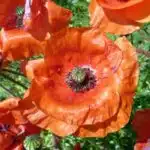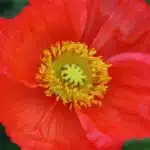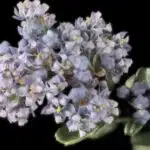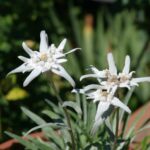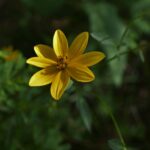The California poppy, Eschscholzia californica, is a beautiful and hardy flower native to the dry and sunny regions of western North America. This poppy species has been used as an ornamental plant in gardens for centuries and has been adopted as the state flower of California. Not only is this species attractive, but it is also easy to grow and can thrive in many different environments. With its bright orange and yellow petals, the California poppy adds a splash of color to any garden or landscape.
In this article we will discuss how to properly care for and grow this delightful plant. We will cover topics such as soil type, water needs, fertilizer requirements, pest control measures, pruning techniques and much more. With these tips you can create an optimal environment for your California poppies to flourish!
Whether you are an experienced gardener or just getting started with botanical cultivation, this guide will provide you with all the information you need to successfully raise healthy California poppies in your own backyard. So if you’re ready to get started on growing this stunning wildflower then let’s jump right into our comprehensive guide on how to care for and grow California poppies!
What Is A California Poppy?
The California poppy is a stunning sight of nature’s beauty, its petals radiating out in vibrant hues of orange, yellow and red. This majestic flower can turn any garden into a picturesque paradise, bringing joy to those who behold it. Botany and gardening enthusiasts alike will delight in learning how to grow and care for this magnificent species.
When planting California poppies, the ideal time is after the last frost has passed and the soil has warmed up. Make sure to choose an area with full sun exposure as they thrive in direct sunlight and require minimal water. Planting them directly in the ground yields the best results; however, if you’re growing them indoors, be sure to use well-draining soil. Additionally, the pH level should be around 6-7; incorporate compost or other natural amendments to adjust the pH levels if necessary.
Once planted, California poppies require very little maintenance beyond occasional watering during dry spells. Deadheading spent blooms keeps plants looking their best and encourages new flowers to form throughout summer and fall. If desired, fertilise every four weeks using a balanced liquid fertiliser at half strength for optimum growth. With just these simple steps followed properly your California poppy will be sure to provide you with colourful blooms all season long!
When And Where To Plant California Poppies
Growing California poppies is like a journey – it starts with choosing the right season and the ideal location. As botanists, we are well aware of how rewarding this beautiful flower can be when planted in its preferred environment. We have all seen how their vibrant colors can light up any garden, so let us discuss when and where to plant these gorgeous blooms.
The best time to sow California poppies is usually in springtime, as soon as the danger of frost has passed. The seeds should be sown directly into the ground and covered lightly with soil. Depending on the climate, this could be anywhere from March to early May. When it comes to location, sunny spots with good drainage are ideal for growing these plants. They thrive in almost any type of soil that retains little water and doesn’t become too compacted.
It’s important to note that California poppies perform well in poor soils – even those which are low in organic matter or slightly acidic will do just fine for them! However, if you want your flowers to look their best and bloom longer, then adding some fertilizer or compost every year will definitely help them reach their full potential. All that said, one thing is certain: when planted properly in an optimal location, these flowers will reward you with a stunning show of color!
Soil Requirements For California Poppies
When it comes to cultivating gorgeous, golden California poppies in the garden, there is no more important step than selecting the right soil. Truly, it’s almost like striking gold – for these delicate flowers to burst with color and life, they need a perfect balance of nutrients, moisture, and drainage. It’s no exaggeration to say that the success of your California poppy garden depends on this one factor!
When scouting for the ideal soil for your California poppies, you’ll want to look for something that is loose and has plenty of organic matter. The pH should be slightly acidic between 6.0 and 7.0. If your soil isn’t quite up to par, don’t fret – you can easily amend it by adding compost or other organic matter such as manure or peat moss. With a bit of prep work, any soil can become a fertile home for these delightful blooms!
If you’re planting in containers or pots rather than directly in the ground, be sure to use a light potting mix that drains well. You’ll want to make sure that the potting mix stays moist but not soggy. To ensure adequate drainage, add some perlite or vermiculite into the mix when planting container-grown California poppies; this will help keep things from getting too waterlogged. TIP: When planting California poppies in containers or pots, check regularly for signs of overwatering such as yellowing leaves and root rot – if this happens quickly adjust your watering schedule accordingly!
California Poppy Planting Tips
When it comes to planting California poppies, there are a few tips to keep in mind for success. To ensure optimal growth, consider the following:
- Select an area with full sun exposure – this will allow the poppy plants to thrive and maximize their potential.
- Plant in well-drained soil – waterlogged soil can be detrimental to their development and should be avoided.
- Space your plants far enough apart for proper air circulation – this will help prevent any fungal diseases from developing on the leaves or stems.
- Incorporate organic matter into the soil before planting – adding some compost or aged manure can help increase the nutrient availability and contribute to healthier plants.
The time of year is also important when planting California poppies, as they do best if planted in cool weather conditions. Spring or early fall are usually the best times, but they can still be planted during other times of the year if necessary. Once planted, regular watering and feeding is critical for their continued growth and development.
Watering frequency and amount will vary depending on climate conditions and soil type; however, it’s generally best to water deeply once per week rather than lightly sprinkle every day. Furthermore, fertilizing every 4-6 weeks during the growing season with a balanced fertilizer can help boost flowering potential and improve overall plant health. With proper care and attention, these vibrant orange blooms will light up your garden with beautiful color!
Watering And Feeding California Poppies
When it comes to watering and feeding California poppies, there are a few things to keep in mind. Firstly, these plants prefer a well-drained soil that never stays soggy. The best way to achieve this is by using a drip irrigation system or watering the poppy’s root zone directly, rather than wetting the foliage. Secondly, California poppies have low nutrient requirements and do not need to be fertilized unless their growth is stunted or their leaves are yellowing or wilting.
If you decide to feed your poppies, use a balanced liquid fertilizer diluted to about one-half of the recommended strength and apply it every two weeks during the growing season. It is important to avoid overfeeding your California poppies as this may lead to excessive leaf growth and fewer blooms.
Finally, be sure to water your poppy plants deeply but infrequently so that they can establish strong roots. As with any other plant, deep watering will encourage deeper roots which are better able to find moisture when needed.
TIP: To ensure healthy growth of your California Poppy plants, make sure they get enough sunlight while avoiding too much direct heat. This means planting them in an area that gets full sun for at least 6 hours per day but also has some protection from afternoon heat.
Controlling Weeds Around California Poppies
Controlling weeds around California Poppies is an important part of their care. Weeds compete with the poppies for resources, and can cause them to suffer if not dealt with in a timely manner. To ensure that your poppies thrive, it’s important to take steps to control weeds.
A great place to start is by using mulch or bark chips around the plants. This will help keep the growth of weeds to a minimum, as well as providing additional nutrients for your poppies. Additionally, you can use pre-emergent herbicides to prevent weed seedlings from taking root in your garden.
Finally, it’s important to regularly pull out any existing weeds by hand. This will not only keep your garden looking tidy, but it will also prevent further spread of weed seeds and help keep your poppies healthy and beautiful. With regular maintenance and care, you can enjoy a stunning display of California Poppies in your garden for years to come! To ensure that your poppies remain healthy and vibrant, it’s also essential to provide them with proper maintenance and care.
California Poppy Maintenance And Care
Maintenance and care of California Poppies is an essential part of the successful cultivation of this plant. Proper maintenance ensures that these flowers will continue to bloom year after year, so it’s important to take some time for regular maintenance. In this section, we’ll discuss the basics of California poppy maintenance and care.
First, it’s important to keep weeds away from California poppies. Weeds can compete with the plants for nutrients in the soil, and can also cause disease if left unchecked. By hand-pulling or using a weed-killer such as glyphosate or triclopyr, you can keep unwanted weeds from taking over your garden.
Second, California poppies should have a few inches of mulch around them to keep their roots cool and moist during hot summers. Not only does this help retain moisture in the soil but it also helps prevent weeds from taking over. Finally, make sure you provide sufficient water during dry spells to ensure that your poppies stay healthy and vibrant all season long.
It’s equally important to deadhead California poppies when they begin to fade; this encourages new blooms throughout the season and prevents seedheads from forming which can make your garden look messy and unkempt. Taking these simple steps will ensure that your poppies remain in good condition for years to come.
Deadheading California Poppies
Deadheading is an important part of maintaining the beauty and health of California Poppies. It involves removing faded, wilting flowers from the plant. This encourages new blooms and helps keep the plants looking their best. As well as being aesthetically pleasing, deadheading can help avoid disease spread by removing seed heads before they become infected.
The process of deadheading is simple, but it’s important to do it correctly in order to get the most benefit from it. Start by snipping off individual faded blooms at a 45-degree angle with clean garden scissors or pruners. Make sure not to cut too close to the foliage; you want to leave some stem so that new growth has room to form buds and blossoms. Doing this regularly throughout the season will keep your poppy plants looking their best and ensure that they don’t succumb to diseases caused by overcrowding or infection.
It’s also important to remember that deadheading itself won’t be enough for your poppies; other maintenance tasks such as fertilizing and watering are also necessary for optimal growth and bloom production. So make sure you’re taking care of all aspects of California Poppy care if you want them to look their best! With proper attention, these magnificent flowers will brighten up any garden or landscape, providing gorgeous color throughout the growing season.
Propagating California Poppies is an easy way to increase their numbers and create a stunning display in your garden or landscape.
California Poppy Propagation
Propagation of California poppies is a great way to increase the number and variety of these beautiful plants in your garden. Take, for example, the case of Jane Smith. Jane wanted to expand her collection of California poppies, so she decided to use propagation methods such as division and seeds. There are several steps you can take to propagate California poppies with success:
- Choose a healthy plant: Select a plant that has bright green foliage, healthy stems and roots, and plenty of blooms.
- Divide the root system: Use two hands or a spade to gently divide the root system into sections.
- Plant divisions in new location: Carefully move each division to its new location in the garden and cover with soil.
- Plant seeds directly in the ground: Prepare an area for sowing poppy seeds by loosening the soil and adding compost if needed.
- Water lightly after planting: Gently water each division or seed mound with a hose or watering can until moistened.
When propagating California poppies through division or seeding, it’s important to take proper care of them during their establishment period. This means providing adequate sunlight, water, nutrients, and protection from pests and diseases. Mulching around them will help keep moisture in the soil while controlling weeds at the same time. With proper attention and care, your newly propagated plants will thrive in your garden! Now that we have discussed how to propagate California poppies successfully, let’s move on to discussing companion planting for these showy flowers.
Companion Planting For California Poppies
California poppies are a bright and cheerful addition to any garden. Their delicate petals and vibrant colors create a stunning flower bed that can bring life to any outdoor space. But what many don’t realize is that companion planting with California poppies can enhance their beauty even further!
By carefully selecting plants for the surrounding area, you can add more color, texture, and even attract beneficial insects to your garden. To get started, consider adding some of the following annuals or perennials: coreopsis, evening primrose, lavender, lupines, yarrows, forget-me-nots, and asters. These plants have similar water needs as the poppies and will provide additional blooms throughout the season while deterring pests with their strong scents.
In addition to these flowering companions, adding some groundcovers such as creeping thyme or pachysandra can help keep weeds at bay while providing a soft contrast beneath the poppies’ blooms. By selecting the right combination of plants for your location’s climate and soil type – you’ll be sure to create a stunning display of color in your garden!
Troubleshooting Common California Poppy Problems
Tending to a garden is like an intricate dance; one wrong step and the entire rhythm can be thrown off. This is especially true when it comes to California Poppies, as there are many potential problems that can arise and throw a wrench into the success of a thriving poppy garden. Here’s how to troubleshoot some of the most common issues that might arise when caring for this beautiful flower.
The biggest issue when caring for California Poppies is ensuring adequate water levels. If they don’t get enough, their blooms will fade quickly and their stems may turn limp. On the other hand, too much water can lead to root rot, so it’s important to find the right balance between wet and dry conditions. The key is to provide regular watering that allows the soil around the plants to remain moist but not soggy.
In addition, keep an eye out for pests such as aphids or slugs that may be lurking in your California Poppy patch. These critters have a taste for these delicate flowers and can cause severe damage if left unchecked. To prevent an infestation, regularly check your plants for signs of pests and take action immediately if you spot any intruders. Applying organic insecticides or introducing beneficial insects into your garden can help ward off any unwanted guests from taking over your poppies.
Finally, it’s important to pay attention to disease prevention measures such as proper spacing between plants and ensuring adequate air circulation around them. This will help reduce the risk of fungal infections like powdery mildew which can quickly overtake a patch of California Poppies if left untreated. Taking precautions such as avoiding overhead irrigation and removing diseased plants from your garden will also go a long way in helping keep your poppies healthy and happy for years to come. With these tips in mind, you’re well on your way towards having a successful poppy garden!
Pests And Diseases Affecting California Poppies
It’s important to know what pests and diseases may affect California Poppies. This is especially true in areas with warmer climates, since they thrive best in cooler temperatures. Unfortunately, there are several insects and fungal diseases that can cause problems when growing this beautiful flower. In this section, we’ll explore the most common pests and diseases that can affect California Poppies.
First, let’s look at some of the insect-borne problems. Aphids and whiteflies are two of the most common insect pests. These small insects feed off of the sap from the plant’s stems and leaves, which can result in stunted growth or discoloration. If left untreated, these pests can even cause complete defoliation of the plant. In addition to these two, a few other insects may also feed on California Poppies, including mealybugs, leafhoppers and caterpillars.
Next up are the fungal diseases that may affect your plants if you live in an area with a more humid climate. Powdery mildew is one such disease that can reduce your crop yield significantly if not treated quickly enough. Rust is another common problem that affects many varieties of poppies; it is characterized by yellow spots on the leaves, followed by reddish-brown spots on their undersides. Finally, Botrytis blight, or gray mold as it’s sometimes called, often appears during periods of high humidity or when waterlogged conditions exist for long periods of time.
Understanding how to prevent or treat these issues is key to maintaining healthy California Poppy plants all season long – so be sure to keep an eye out! With proper care and regular monitoring for pest activity and disease symptoms, you’ll be sure to have a successful harvest each year!
Uses For California Poppies
The vibrant, sunny color of California poppies bring a ray of sunshine to any garden. As beautiful as they are, these flowers are also incredibly useful. Let’s look at the many uses for this wondrous flower.
To start, California poppies can be used in ornamental gardens and landscapes. They’re perfect for adding some drama and texture to a space with their stunning blooms and fern-like foliage. Additionally, they make excellent cut flowers and can be dried for use in dried arrangements or pressed for craft projects. Furthermore, their petals are edible so you can sprinkle them on salads or use them as a garnish on dishes. Finally, these cheerful blooms attract bees and other pollinators to your garden which is essential for healthy plants and a thriving ecosystem.
The delicate petals of California poppies also make them ideal for creating homemade skincare products like lotions, ointments and salves. Their anti-inflammatory properties help reduce redness and irritation while soothing dryness or inflammation of the skin. Plus, they offer natural sun protection due to their high antioxidant content. When made into tea or tinctures, they can provide relief from digestive issues as well as insomnia and headaches caused by stress or tension.
These versatile flowers have something to offer everyone – from gardeners looking to add some beauty to their outdoor space to those seeking natural remedies for common health concerns – making the California poppy an indispensable addition to any garden!
Harvesting California Poppies
Harvesting California poppies is an important part of the plant’s care and growth. As a specialist in botany and gardening, I will provide you with the knowledge needed to harvest these beautiful flowers successfully.
Firstly, it is essential to time the harvest correctly. The best time to pick California poppies is early in the morning when the dew has just dried off and the petals of the flower are just opening. To ensure maximum freshness, they should be picked at this time. Additionally, when picking poppies from your garden, make sure that you do not pluck off more than half of a single plant’s flowers at one time as this can weaken their flowering power for next year’s blooms.
To help you remember how to properly harvest California poppies, here are four key points: • Harvest early in the morning • Pick no more than half of a plant’s flowers at once • Gently pull on each flower’s stem away from its base • Place harvested petals in a clean container to avoid wilting
This knowledge will help you maintain vibrant blooms throughout your growing season by ensuring that your plants are not over-harvested or damaged during harvesting. With proper care and attention, you can enjoy these beautiful wildflowers for years to come! Now let us turn our focus towards exploring the varieties of California poppies available today…
California Poppy Varieties
It’s ironic that we often think of poppies as being such a uniform flower, when in fact there are actually a wide variety of varieties available. California poppies are no exception: there are many different kinds, each with its own unique characteristics. As a specialist in botany and gardening, I’m here to give you the insider scoop on these beautiful plants.
The most commonly seen variety of California poppy is Eschscholzia californica, which grows up to 12 inches tall and features bright orange-yellow petals surrounding a yellow center. However, there are also other varieties available; some are taller or shorter than the average height, some feature more vibrant colors than others, and some have double-petaled flowers instead of single ones. All varieties need full sun and well-draining soil to thrive, but beyond that they can be quite low maintenance.
If you’re looking for something different from the typical California poppy, why not try one of the other varieties? For example, ‘Mission Bells’ is a shorter variety with soft pastel petals in shades of pink and lavender; ‘Cupcake’ has frilly yellow petals that resemble cupcake frosting; or ‘Apricot Chiffon’ has fringed petals in shades ranging from apricot to cream. Whatever your preference may be, there’s sure to be a California poppy variety that will suit your needs!
From subtle pastels to bright oranges and yellows, these eye-catching blooms are sure to make any garden stand out—and they require minimal care once established. So why not give one (or two!) of these gorgeous varieties a try? You won’t regret it!
Frequently Asked Questions
How Long Does It Take For California Poppies To Bloom?
As soon as the sun peeks its head out, an explosion of vibrant orange, yellow and white petals will come to life! The California Poppy is a sight to behold, with its delicate blossoms that can last for days. But how long does it take for this beautiful bloom to transform a barren landscape?
The answer may surprise you – only a few short weeks! That’s right – this stunning plant doesn’t take long at all to burst into full flower. Its blooming period varies depending on the climate, but generally speaking, it takes between four and six weeks from seed germination until you can enjoy its fragrant blooms in all their glory.
But don’t be fooled by the seemingly speedy growth of the California Poppy! This resilient little flower requires some TLC in order to reach its fullest potential. It needs plenty of sunlight, well-draining soil, and regular watering during dry spells. With just a bit of care and attention, your poppy garden will be thriving in no time!
Is It Safe To Grow California Poppies With Other Flower Varieties?
As a specialist in botany and gardening, I’m often asked if it’s safe to grow California poppies with other flower varieties. The answer is yes – California poppies are quite adaptable to different types of soil and climate conditions, so they make an excellent companion plant for other flowers.
When planting with other flowers, it’s important to consider the growth habits of each species. For example, some flowers may spread rapidly and crowd out your California poppies, while others require frequent deadheading or pruning which could affect the overall look of your garden. It’s also important to note that some flowers may provide too much shade for your poppies to thrive.
By selecting companion plants that meet the needs of both your California poppies and other flower varieties, you can ensure a beautiful garden full of vibrant colors and textures! With careful planning and thoughtful maintenance, you’ll be able to create a lush landscape filled with blooms all season long.
With a little bit of research and preparation, you can safely enjoy the beauty of both California poppies and other flower varieties in your garden.
How Often Should California Poppies Be Watered?
Watering California poppies is an art form that needs to be mastered! While they are incredibly hardy and drought tolerant, they also require water in order to grow and thrive. So, how often should you water your California poppies? Let’s take a look.
As with all flowers, it’s important to never over-water your poppies. In fact, if you give them too much water, it could lead to an almost immediate death of the plant. To ensure optimal health and growth, aim to water your poppies once a week – or twice if the weather is particularly hot. When watering, make sure the soil around each flower is thoroughly drenched; this will guarantee deep hydration for each plant.
It’s also worth noting that if you live in a particularly dry area, you may need to supplement natural rainwater with additional watering from your hose or watering can. Doing this correctly ensures that your beloved California poppies stay healthy and gorgeous – like glorious stars twinkling in your garden! After all, no one wants their flowers wilting under the hot summer sun!
So when it comes to keeping your California poppies happy and healthy, remember: water them regularly but not too much – just enough so they can reach their full potential! With a bit of TLC (tender love and care), these resilient beauties will reward you with an abundance of colour for years to come.
Are There Any Special Requirements For Planting California Poppies In Containers?
California poppies are among the most eye-catching and beautiful flowering plants, with their bright orange blooms that bloom from late winter to early summer. It’s no surprise then that they’re popular for planting in containers. But did you know that approximately 40% of California poppy seeds require light for germination? This means there are certain requirements for successfully planting California poppies in containers. Here’s what you need to know:
First and foremost, it’s best to use a container with drainage holes on the bottom, as well as a potting soil mix formulated specifically for cacti and succulents. The soil should be light and sandy, so water can easily drain away from the roots of the flower. Additionally, ensure your container is deep enough to accommodate the root system of your California poppy – at least 7 inches deep.
After finding the right container and soil mix, you’ll want to plant your seeds lightly so they’re just covered by a thin layer of soil or sand. Water them gently but thoroughly after planting, making sure not to over saturate the soil or dislodge any of the tiny seeds. During this time, remember that California poppies need full sun exposure – at least 6 hours per day – so make sure you put them in an area where they will get plenty of sunlight!
As far as maintenance goes, California poppies need to be watered about once every week or two during active growth periods. Also keep an eye out for pests like aphids; if you spot any on your plants, treat them with a neem oil spray according to package instructions. With proper care and attention, these vibrant flowers will continue to bring beauty and color into your garden all season long!
How Do I Know When It’s Time To Prune My California Poppies?
Planting California poppies in containers can be a great way to bring some color and cheer into your home. However, there are certain requirements that need to be met to ensure the best possible results. One of the most important aspects is knowing when to prune your plants.
Pruning is an important part of caring for any plant, but it’s especially important when it comes to California poppies. Pruning helps keep the plants healthy and encourages new growth. It’s also necessary for maintaining the shape of the plant and keeping its size under control. To determine when it’s time to prune your California poppies, look for signs such as yellowing leaves or excessive growth. If you notice these signs, prune back the affected areas as soon as possible.
When pruning California poppies, always use sharp pruning shears and make sure that you cut back just enough so that new growth will start appearing within a week or so. Prune away any dead or diseased parts of the plant first, then focus on trimming areas where there is too much growth. Be sure not to over-prune; remember that too much pruning can limit the amount of blooms that will appear on the plant during its flowering season! With proper care and attention, you can create a stunning display of colorful blooms with your container-grown California poppies!
Conclusion
The California poppy is a resilient and beautiful flower that has been beloved by gardeners around the world for centuries. Despite its delicate appearance, it is incredibly hardy and can tolerate a wide variety of climates and soil types. With proper care and maintenance, the California poppy will reward you with its vibrant show of color each spring.
It has long been held that the best way to ensure a bountiful bloom season is to plant poppies in early spring. While this may be true in terms of timing, careful consideration must also be taken when selecting companion plants for the poppy, as some varieties can stunt its growth or overpower its delicate beauty. Additionally, poppies must be watered regularly but not too much; too little water can cause them to wilt, while too much water can lead to root rot. Finally, pruning poppies in late summer or early fall can help ensure a healthier plant and more abundant blooms next season.
When it comes to growing California poppies successfully, there are many factors that need to be taken into account in order for the flowers to thrive. However, with some patience and knowledge of their needs, gardeners will be able to enjoy their vibrant blooms year after year.


